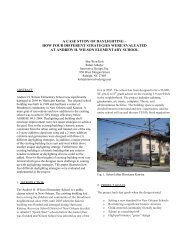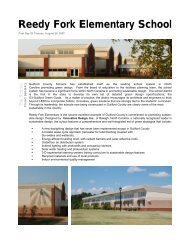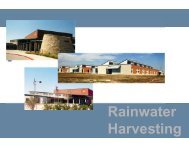SOLAR TODAY - May 2011 - Innovative Design
SOLAR TODAY - May 2011 - Innovative Design
SOLAR TODAY - May 2011 - Innovative Design
You also want an ePaper? Increase the reach of your titles
YUMPU automatically turns print PDFs into web optimized ePapers that Google loves.
advances<br />
| policy<br />
“[Tying a tax credit] to economic development — that seems to be the easier row to hoe.”<br />
— Steve Kalland, North Carolina Solar Center<br />
It’s critical for the industry to offer mechanisms that bring<br />
to the table the needs of states, as well as of renewable energy<br />
interests, says Kalland. “[Tying a tax credit] to economic<br />
development — bringing jobs into the state, bringing investment<br />
into the state, in a way that’s going to increase state<br />
revenues — that seems to be the easier row to hoe,” he adds.<br />
“And certainly in the Southeast, it seems to be much more in<br />
tune with what’s palatable for legislators.”<br />
Since the REPS went into effect in 2007, Asheville,<br />
N.C.-based FLS Energy has installed enough solar thermal<br />
capacity to heat more than 500,000 gallons of water every<br />
day at a facilities across the state. CEO Michael Shore credits<br />
good policy, which allows solar thermal to count toward<br />
FLS Energy<br />
North Carolina’s REPS. “Once solar incentives were put<br />
in place,” he said, “capitalism did its job and businesses<br />
followed opportunities.”<br />
Indeed, the latest NCSEA jobs survey finds more than<br />
100 solar energy companies in the state, employing more<br />
than 1,500 people. Hundreds of more companies in the<br />
state have secondary or tertiary business in solar. Since<br />
the REPS was adopted, the cost of installed solar in North<br />
Carolina has fallen a whopping 49 percent, according to<br />
Urlaub. Perhaps most importantly, he says, regulators, utilities<br />
and legislators are learning that an integrated electricity<br />
portfolio including renewables and efficiency actually<br />
costs less than one without. “This is a paradigm shift,” says<br />
Urlaub, and one that, as the state establishes a solar supply<br />
chain, will position it to reap economic-development benefits<br />
as solar reaches grid parity nationwide.<br />
Because of falling solar prices, the utilities have already<br />
met their requirements for solar for the next few years. The<br />
legislature is now considering House Bill 495 and Senate<br />
Bill 473, which would double the solar set-aside to 15 percent<br />
by 2018. Action is due by the end of the summer.<br />
Back in Georgia, the policy wish list includes passing<br />
HB 146 to expand the cap on the tax incentive, and revising<br />
the state territorial act to allow solar PPAs. One way Georgia<br />
solar advocates hope to emulate North Carolina’s success is by<br />
focusing more effectively on jobs creation, says Georgia Solar<br />
Energy Association Chair Doug Beebe.<br />
“We’ve had to get creative in the difficult budget year<br />
we’re having in Georgia,” says Beebe. “It’s not enough to<br />
say, ‘solar creates jobs.’ You’ve got to say, ‘solar creates<br />
jobs and this is going to be the net-positive benefit to tax<br />
revenue generation.’”<br />
Family Farm from page 14<br />
Methane digester operation is based on anaerobic<br />
decomposition, the breaking down of manure and other<br />
organic matter by bacteria in the absence of oxygen. The<br />
methane produced can be used in place of natural gas for<br />
Farms and Ranches with Renewable Energy Systems<br />
Photovoltaic panels – 7,236<br />
Thermal solar panels – 1,835<br />
Wind turbines – 1,420<br />
Methane digesters – 121<br />
Wind turbines on farmland under a wind rights lease agreement and<br />
methane digesters not owned and operated by the farm were excluded.<br />
Source: On-Farm Renewable Energy Production Survey by the U.S. Department<br />
of Agriculture<br />
heating and drying operations and to power standby electric<br />
generators, and the effluent can be applied as fertilizer. Methane<br />
digesters are popular for reducing farmyard odors.<br />
Many farmers have found it cost-effective to replace<br />
old equipment with energy-efficient models, to improve<br />
building insulation and to implement more sustainable<br />
farming practices. For example, variable-speed drive<br />
pumps consume half the energy of fixed-speed pumps,<br />
and drought-resistant crops further cut energy costs by<br />
reducing irrigation needs.<br />
U.S. farming will face challenges in the future as energy<br />
prices rise and the climate warms. For many farms, the savings<br />
achieved through renewable energy technologies can<br />
make the difference between a sustainable operation and<br />
one that is struggling to stay in business. ST<br />
20 <strong>May</strong> <strong>2011</strong> <strong>SOLAR</strong> <strong>TODAY</strong> solartoday.org Copyright © <strong>2011</strong> by the American Solar Energy Society Inc. All rights reserved.









